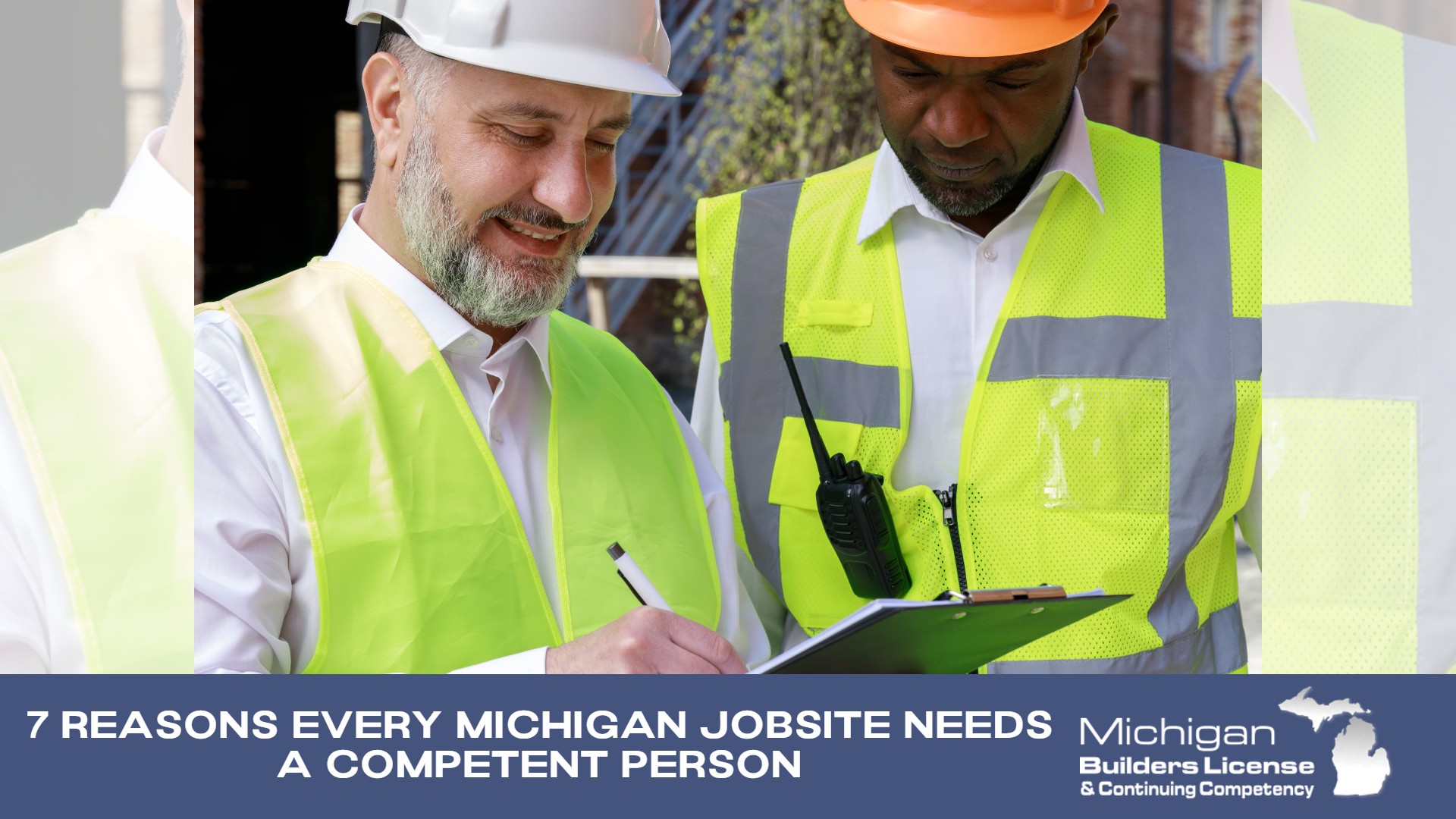If you build in Michigan, MIOSHA expects a competent person on your jobsite. That means someone with the knowledge and authority to spot hazards and fix them on the spot. It’s not just good safety practice; it’s serious liability reduction and better project control. Below is a quick, list-style guide you can share with your field leads and subs.
1) Know the definition (and why it matters)
MIOSHA defines a competent person as someone capable of identifying existing and predictable hazards and who has the authorization to take prompt corrective measures to eliminate them (CS-9 Excavation, Trenching, and Shoring).
Without that authority piece, you’re not meeting the Michigan standard.
2) MIOSHA requires an Accident Prevention Program (APP) and your competent person makes it real
MIOSHA Construction Safety Standards require every employer to develop and maintain an Accident Prevention Program (Rule 114). This plan must be available at the worksite and include employee involvement.
Your competent person is the natural lead for putting the APP into practice: conducting inspections, documenting training, and closing safety gaps in the field.
3) Fall protection: train, document, and enforce
Under MIOSHA Part 45, Fall Protection, residential and commercial builders must provide fall protection for employees working at heights of 6 feet or more.
A competent person ensures the right fall protection system is selected for each jobsite, workers are properly trained, and documentation is ready when an inspector asks.
4) Scaffolding: inspections and setup must be led by a competent person
Scaffolds must be erected, moved, dismantled, or altered under the supervision of a competent person. Before each shift, and after any event that could affect stability, a competent person must inspect scaffolds for visible defects.
Scaffold citations remain among the most common and costly enforcement actions under MIOSHA.
5) Excavations: daily inspections aren’t optional
Under MIOSHA Part 9, Excavation, Trenching, and Shoring, and OSHA Subpart P, a competent person must inspect:
- Excavations,
- Adjacent areas, and
- Protective systems
…daily, before work starts, and after rain or other hazard-increasing events. Cave-ins remain a leading cause of fatalities, and a competent person is responsible for verifying sloping, shoring, shielding, and access/egress every shift.
6) Recordkeeping & posting to prevent penalties
MIOSHA enforces federal recordkeeping rules requiring contractors to maintain injury and illness records (Forms 300, 300A, 301). The 300A summary must be posted from February 1 to April 30 each year.
While the employer is responsible, a competent person helps ensure reports are accurate, logs are current, and postings are in place — saving the company from costly citations.
7) Toolbox talks & operator qualifications
From ladders and guardrails to aerial lifts and forklifts, a competent person verifies operator qualifications and documents toolbox talks so there’s proof that training occurred.
MIOSHA’s fall protection fact sheets and excavation standards both highlight the importance of competent-person oversight and documentation.
Bottom line for liability reduction
Designating (and empowering) a competent person:
- Prevents injuries by closing hazards in real time.
- Protects your company with the documentation MIOSHA expects.
- Speeds inspections because your binder, postings, and training logs are already in order.
Learn this (and more) in 3 hours with Sid Woryn
This topic and the practical ways to implement it on Michigan jobsites are reviewed in Michigan Builders License’s 3-Hour Continuing Competency course taught by Master Instructor Sid Woryn.
It’s built to help you reduce liability, pass inspections, and protect your team. Grab your seat or get it done online today. Click here to see more.
Sources & References
- CS-9 Excavation, Trenching, and Shoring Standard – Competent person definition and daily inspection requirements
https://www.michigan.gov/leo/-/media/Project/Websites/leo/Documents/MIOSHA/Standards/Construction/CS_09/CS_09__03-14-2013.pdf -
CS-9 Updated Standard (2024, effective Jan 3, 2024) – Latest revisions to excavation and competent person rules
https://www.michigan.gov/leo/-/media/Project/Websites/leo/Documents/MIOSHA/Standards/Construction/CS_09/LEO-MIOSHA-CS-9-Strike-bold---Eff-1-3-2024.pdf -
Part 45 – Fall Protection (Construction Safety Standard) – Fall protection trigger height and requirements
https://www.michigan.gov/leo/-/media/Project/Websites/leo/Documents/MIOSHA/Standards/Construction/CS_45/CS_45__04-06-2015.pdf -
MIOSHA Fact Sheet CET #180 – Fall Protection Highlights – Plain-language explanation of the standard
https://www.michigan.gov/-/media/Project/Websites/leo/Documents/MIOSHA/Fact-Sheets/CET/Fact_CET180.pdf -
Part 9 – Excavation, Trenching, and Shoring (Strike-bold draft) – State-specific excavation standards
https://thinkmita.org/miosha-releases-new-excavation-trenching-and-shoring-standards -
Mich. Admin. Code R. 408.41510 – Definitions – Competent person definition in Michigan Admin Code
https://www.law.cornell.edu/regulations/michigan/Mich-Admin-Code-R-408-41510 -
Mich. Admin. Code R. 408.42910 – Fall Protection Rule – Michigan code requiring fall protection at 6 feet
https://www.law.cornell.edu/regulations/michigan/Mich-Admin-Code-R-408-42910 -
MIOSHA News – Summer 2025 – Real enforcement example citing competent person and fall protection violations
https://content.govdelivery.com/accounts/MILEO/bulletins/3e38de1





